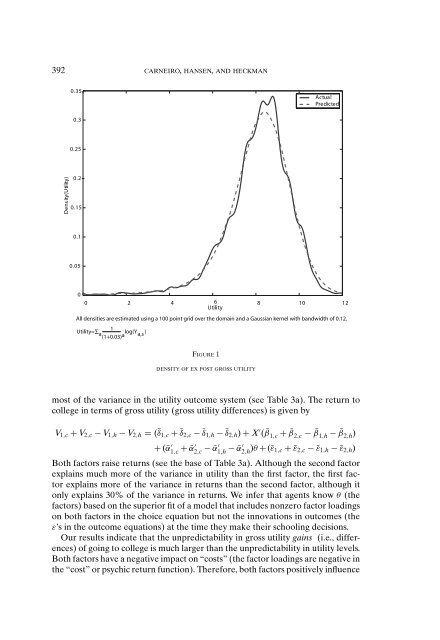Estimating Distributions of Counterfactuals with an Application ... - UCL
Estimating Distributions of Counterfactuals with an Application ... - UCL
Estimating Distributions of Counterfactuals with an Application ... - UCL
Create successful ePaper yourself
Turn your PDF publications into a flip-book with our unique Google optimized e-Paper software.
392 CARNEIRO, HANSEN, AND HECKMAN<br />
0.35<br />
Actual<br />
Predicted<br />
0.3<br />
0.25<br />
Dens ity(Utility)<br />
0.2<br />
0.15<br />
0.1<br />
0.05<br />
0<br />
0 2 4 6 8 10 12<br />
Utility<br />
All densities are estimated using a 100 point grid over the domain <strong>an</strong>d a Gaussi<strong>an</strong> kernel <strong>with</strong> b<strong>an</strong>dwidth <strong>of</strong> 0.12.<br />
Utility=<br />
1<br />
Σ a(1+0.03) a log(Y a,s )<br />
FIGURE 1<br />
DENSITY OF EX POST GROSS UTILITY<br />
most <strong>of</strong> the vari<strong>an</strong>ce in the utility outcome system (see Table 3a). The return to<br />
college in terms <strong>of</strong> gross utility (gross utility differences) is given by<br />
V 1,c + V 2,c − V 1,h − V 2,h = (¯δ 1,c + ¯δ 2,c − ¯δ 1,h − ¯δ 2,h ) + X ′ ( ¯β 1,c + ¯β 2,c − ¯β 1,h − ¯β 2,h )<br />
+ (ᾱ<br />
1,c ′ + ᾱ′ 2,c − ᾱ′ 1,h − ᾱ′ 2,h )θ +(¯ε 1,c + ¯ε 2,c − ¯ε 1,h − ¯ε 2,h )<br />
Both factors raise returns (see the base <strong>of</strong> Table 3a). Although the second factor<br />
explains much more <strong>of</strong> the vari<strong>an</strong>ce in utility th<strong>an</strong> the first factor, the first factor<br />
explains more <strong>of</strong> the vari<strong>an</strong>ce in returns th<strong>an</strong> the second factor, although it<br />
only explains 30% <strong>of</strong> the vari<strong>an</strong>ce in returns. We infer that agents know θ (the<br />
factors) based on the superior fit <strong>of</strong> a model that includes nonzero factor loadings<br />
on both factors in the choice equation but not the innovations in outcomes (the<br />
ε’s in the outcome equations) at the time they make their schooling decisions.<br />
Our results indicate that the unpredictability in gross utility gains (i.e., differences)<br />
<strong>of</strong> going to college is much larger th<strong>an</strong> the unpredictability in utility levels.<br />
Both factors have a negative impact on “costs” (the factor loadings are negative in<br />
the “cost” or psychic return function). Therefore, both factors positively influence
















